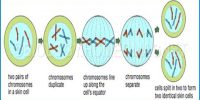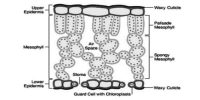Meiosis: The kind of cell division in which the nucleus of reproductive mother cell (2n) divides twice and chromosome divides one time through a series of complicated changes and gives rise to four daughter nuclei of which each daughter nucleus bears the same number of chromosomes and, changed characteristics of its mother cell is known as meiosis.
It always occurs in reproductive mother cells (2n). For lower type of plants (haploid plants) meiosis occurs in zygotes (2n) after fertilization to restore the haploid character of the plants. For higher type of plants meiosis occurs in reproductive mother cells in order to produce gametes before fertilization.
For the convenience of discussion meiosis is divided into the following stages:
i) First meiosis or Reductional division.
ii) Second meiosis or Equational division.
First meiosis (meiosis-1) is divided into four steps:
a) First prophase.
b) First Metaphase.
c) First Anaphase &
d) First Telophase.
First prophase is again divided into five sub-steps:
1) Leptotene
2) Zygotene
3) Pachytene
4) Diplotene and
5) Dia-kinesis.
Second meiosis also has four Steps:
1) Second Prophase or Prophase-2
2) Second Metaphase or Metaphase-2
3) Second Anaphase orAnaphase-2
4) Second Telophase or Telophase-2
Meiosis is called reductional division; because-
1. This type of division occurs in reproductive mother cell of diploid organism or in zygote (2n) of tosser type of plants.
2. In this division , the nucleus undergoes division twice passing through a series of complicated changes giving rise to four daughter nuclei where each daughter nucleus bears half the number of chromosome of its mother cell (2n).
Thus meiosis is called Reductional division.
Characteristics of meiosis:
1. Usually meiosis occurs in reproductive mother cells of diploid organisms.
2. In this type of cell division, nucleus divides twice but chromosome divides once.
3. Since Prophase-1 is a lengthy process it can be divided into five sub- phases.
4. Homologous chromosomes form bi-valent by making pairs (synapsis).
5. Genetic exchange Occurs because of the formation of chiasma and crossing over.
6. Four haploid daughter cells are formed.
7. Chromosome gets different arrangement.
8 The daughter cells are formed in this process due to crossing over and different arrangement of chromosomes are not identical in properties. This is very significant in the formation of varieties.
The significances of meiosis are as follows:
1 . To keep the chromosomal number constant: By meiosis it is only possible to keep the chromosome number constant from generation to generation. If there had been no meiosis in reproductive mother cells (2n) of higher plants and animals or in zygote (2n) of haploid plants, chromosome number would be doubled in each generation and thus the species character will be hampered.
2. To keep species character constant: By keeping constancy of the chromosomal number, species characteristics can be maintained from generation to generation.
3. Formation of diversity: No two organisms that are capable of sexual reproduction are precisely alike. Though all the people in the world are of same species, they differ from each other. This variations occur in the organisms of the world, because crossing over takes place in the chromosomes of the gametes during meiosis cell division.
4. Evolution: Meiosis brings variation and variation brings the trend of evolution.
5. Formation of gametes and reproduction: Gametes are formed by meiosis in diploid organisms. Different gametes unite together in the sexual reproduction giving rise to new generation.












